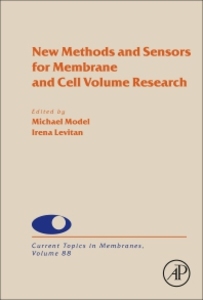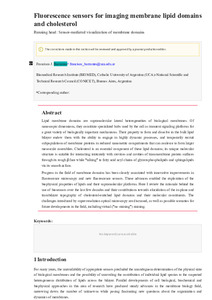Please use this identifier to cite or link to this item:
https://repositorio.uca.edu.ar/handle/123456789/14078| Título: | Fluorescence sensors for imaging membrane lipid domains and cholesterol | Autor: | Barrantes, Francisco José | Palabras clave: | BIOSENSORES; COLESTEROL; MICROSCOPIO FLUORESCENTE; SONDAS FLUORESCENTES; DISTRIBUCIÓN EN EL PLANO; SIMETRÍA DE LÍPIDOS; DOMINIO LIPÍDICO; DOMINIOS DE MEMBRANA; NANOSCOPIA; SENSORES; MICROSCOPÍA DE SUPERRESOLUCIÓN; DISTRIBUCIÓN TRANSBICAPA; TINCIÓN VIRTUAL | Fecha de publicación: | 2021 | Editorial: | Academic Press | Cita: | Barrantes, F. J. Fluorescence sensors for imaging membrane lipid domains and cholesterol [en línea]. En: Modell, M., Levitan, L. New Methods and Sensors for Membrane and Cell Volume Research. [s.l.] : Academic Press, 2021. doi: 10.1016/bs.ctm.2021.09.004 . Disponible en: https://repositorio.uca.edu.ar/handle/123456789/14078 | Resumen: | Abstract: Lipid membrane domains are supramolecular lateral heterogeneities of biological membranes. Of nanoscopic dimensions, they constitute specialized hubs used by the cell as transient signaling platforms for a great variety of biologically important mechanisms. Their property to form and dissolve in the bulk lipid bilayer endow them with the ability to engage in highly dynamic processes, and temporarily recruit subpopulations of membrane proteins in reduced nanometric compartments that can coalesce to form larger mesoscale assemblies. Cholesterol is an essential component of these lipid domains; its unique molecular structure is suitable for interacting intricately with crevices and cavities of transmembrane protein surfaces through its rough β face while "talking" to fatty acid acyl chains of glycerophospholipids and sphingolipids via its smooth α face. Progress in the field of membrane domains has been closely associated with innovative improvements in fluorescence microscopy and new fluorescence sensors. These advances enabled the exploration of the biophysical properties of lipids and their supramolecular platforms. Here I review the rationale behind the use of biosensors over the last few decades and their contributions towards elucidation of the in-plane and transbilayer topography of cholesterol-enriched lipid domains and their molecular constituents. The challenges introduced by super-resolution optical microscopy are discussed, as well as possible scenarios for future developments in the field, including virtual ("no staining") staining. | URI: | https://repositorio.uca.edu.ar/handle/123456789/14078 | ISBN: | 9780323911153 | Disciplina: | MEDICINA | DOI: | 10.1016/bs.ctm.2021.09.004 | Derechos: | Acceso abierto | Fuente: | Modell, M., Levitan, L. New Methods and Sensors for Membrane and Cell Volume Research. [s.l.] : Academic Press, 2021 |
| Appears in Collections: | Libros o partes de libro |
Files in This Item:
| File | Description | Size | Format | |
|---|---|---|---|---|
| fluorescence-sensors-imaging-cover.jpg | 18,62 kB | JPEG |  View/Open | |
| fluorescence-sensors-imaging.pdf | 1,09 MB | Adobe PDF |  View/Open |
Page view(s)
65
checked on Apr 27, 2024
Download(s)
272
checked on Apr 27, 2024
Google ScholarTM
Check
Altmetric
Altmetric
This item is licensed under a Creative Commons License

